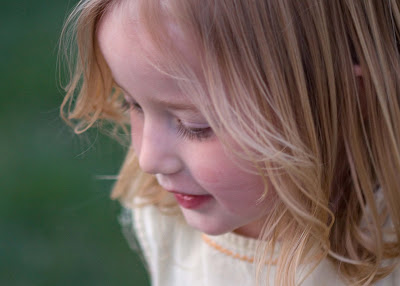

So, here are a few pics from a recent impromptu photo session. Our three-year old neighbor wandered over to see if my youngest daughter could play. Recognizing good overcast lighting (see post #1), I grabbed the camera and began shooting away. (Generally, I don't advise photographing children without asking their parents permission first, but these are close--and understanding--friends.)
See any smiles? Me neither, but I was still happy with the results. Sure, I know, we all love smiles, but in children's photography I do think one can get "too much of a good thing." Kids khow the drill, right? You pull out the camera, they put on a fake smile, the camera goes click and ... whew! ... they go back to doing whatever they were doing before being so rudely interrupted.
So, I think it's safe to say we want (1) genuine smiles, and (2) maybe not smiles at all. Sometimes it's great to simply capture a kid being a kid. They aren't always smiling after all, and many of their most interesting and charming expressions aren't necessarily the smiliest ones.
To that end, I suggest the following, general approach: first, don't ask or expect a child to smile immediately. You want the child to get comfortable with you and the camera, so introduce yourself. Show them the camera. Engage them in conversation. Ask them about their interests, about the weather, about anything at all. While doing so, you can often check the lighting, adjust camera or lens, and then start shooting--all before a single "say cheese" has escaped your lips.
The photo session with my little neighbor went someone like this: "Can I take your picture? Can you stand right here? Thank you sooo much!! How old are you? Three? Wow, you're getting sooo big. What's that stuck in your hair? Is there a monkey on my head? (This, to get her to look up.) What color is that monkey? ..." You get the idea. I wouldn't recommend taking that approach with a fifteen year-old, but, hey, with a three year-old, anything goes.

